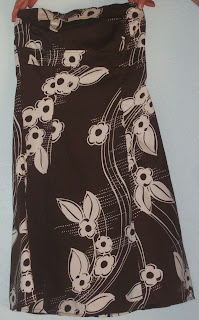Here's another dress I found on the same trip as the last one, and the problems with it are rather similar as well. The dress was cute, but way too high, had a slit, could benefit from some sleeves and on top of that it was too low. Well, being that I had so many dimensions that needed to be added too, I decided to give the dress some color - I don't know how well you can see it, but I bought some lavender gauze with black and white flower thingys on it. I got about a yard of it at Joanns (again, the place has awesome sales and coupons pretty much all of the time) and started playing :)
Naturally, before I could start adding pretty lavender fabric onto the dress, I had to make it so that I could add onto it, which meant I needed to close the slit up. Being that the edges of the slit overlapped, all I needed to do was line them up and stitch along the edge of the top one - the second picture shows it done - which was nice and simple!


Then to lengthen it I decided to make a ruffle. All you have to do for a ruffle is cut a long piece (or more than one piece like I did) of fabric that is just a bit taller than you need/want added onto the length of your dress. Then you just sew them together (with right sides matching) and make a big circle. Then you need to finish the bottom of the ruffle, you can hem it like I did with the last dress, but being that I was using gauze, which is a really thin, slippery fabric that simply doesn't like to be hemmed (or maybe it just doesn't like me hemming it, it might like you), I just did a really thin serger stitch along the bottom. Then you need to do some finishing on the top so the fabric doesn't unravel, so just like a zigzag, or regular serger seam. Whew, that was a rather long winded explanation :) Anyways, here's what it ended up looking like.

Next you need to gather the ruffle, in other words, make the stitches as long as you can on your machine, stitch right along the top of the ruffle and leave your threads long. Then you pull either the bottom or the top thread and the fabric bunches. As this ruffle is on the bottom of a dress, you will have to do quite a bit of pulling (it's okay if you do too much). Then you pin the ruffle to the dress matching the middle front and back and the sides - I put the ruffle behind the dress and just sewed along the top so the ruffle laid nicer. Whichever way you want to do it, make sure you start sewing on the end of your gathering stitch so if you bunched the fabric too much or too little you still have the other end of the stitch to work with!


Okay, now onto the sleeves. I picked one slightly puffed because I thought it would look nice with the ruffle, which just means I took in some tucks, pinned them, so they got sewn in when I did the finishing seam on the bottom of the sleeve. Then I sewed the ends together and finished the top of the sleeve with a larger serger seam. Now match the tops and bottoms of the sleeved with the tops and bottoms of the armholes (depending on which type of sleeve you want to do, you might have to gather the top of the sleeve a bit to make it fit, puff or whatever) and stitch them together. I just did the same thing with the sleeves as I did with the ruffle, put the finished edge of the sleeve slightly under the dress and stitch along the top.


Last, but not least, the dress needed some neckline attention! You could just stich a piece of fabric or some lace across the top like we did with the first shirt, but I wanted to do something with some dimension. So I cut a rectangle just slightly wider than I needed and much taller than that and finished the four sides. Then I gathered the sides and bunched them as tightly as I could and sewed it to keep it in place. Then, because I didn't want any stitching on the neckline of this dress, I bought some sticky velcro dots, put one side on the ends of the insert and the other on the inside of the dress.
And there we go! - a much more modest (and colorful) version of the dress :)









































